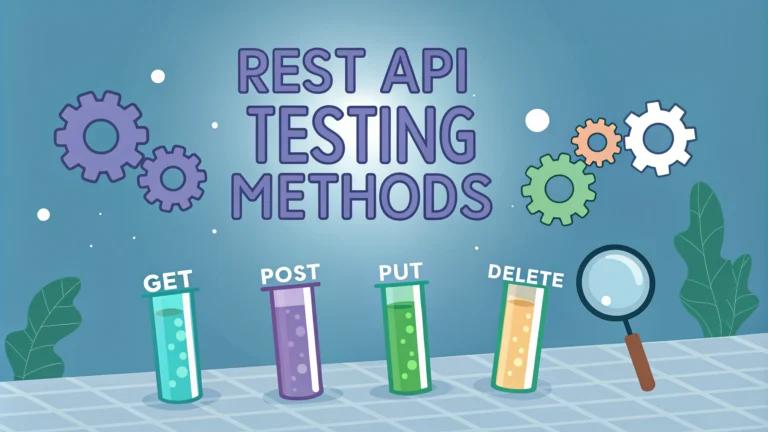REST API testing methods help identify security vulnerabilities, performance bottlenecks, and functionality issues before deploying applications to production.
Penetration testing REST APIs requires specialized tools, techniques, and methodologies to effectively uncover potential security risks and weaknesses.
This guide covers essential REST API testing approaches, tools, and best practices for conducting thorough security assessments.
Authentication Testing
- Test for weak password policies and brute force protection
- Verify JWT token implementation and validation
- Check OAuth 2.0 flow security if implemented
- Validate session management and timeout settings
Authorization Testing
Test horizontal and vertical privilege escalation scenarios by manipulating user roles and permissions.
Common Authorization Checks:
- Access to unauthorized resources
- Role-based access control (RBAC) bypass attempts
- API endpoint permission validation
- Resource ownership verification
Input Validation Testing
- SQL injection attempts using tools like SQLmap
- Cross-site scripting (XSS) payload testing
- Mass assignment vulnerability checks
- File upload security validation
Recommended Testing Tools
| Tool | Purpose |
|---|---|
| Burp Suite | Web security testing and vulnerability scanning |
| Postman | API testing and documentation |
| OWASP ZAP | Open-source security testing |
Rate Limiting Tests
- Test API request throttling mechanisms
- Verify rate limit bypass protections
- Check quota enforcement accuracy
Data Exposure Testing
Check for sensitive data exposure in API responses, error messages, and logs.
Key Areas to Test:
- PII (Personally Identifiable Information) leakage
- Error message verbosity
- Debug information exposure
- API documentation security
Performance Testing
- Load testing with tools like Apache JMeter
- Response time measurement under various conditions
- Concurrent request handling capability
- Resource consumption monitoring
Security Headers Testing
Verify implementation of security headers using tools like SecurityHeaders.com.
Essential Headers to Check:
- Content-Security-Policy
- X-Frame-Options
- X-XSS-Protection
- Strict-Transport-Security
Securing Your REST APIs
Implement continuous security testing as part of your development pipeline using automated tools and manual testing procedures.
Security Checklist:
- Regular vulnerability assessments
- Updated security patches
- Proper error handling
- Input sanitization
- Encryption in transit and at rest
Contact OWASP API Security Project for additional guidance on API security testing standards and best practices.
API Documentation Testing
- Verify API documentation accuracy
- Test example requests and responses
- Check versioning information
- Validate endpoint descriptions
Encryption Testing
Validate data encryption implementation both in transit and at rest.
Key Testing Areas:
- SSL/TLS configuration
- Certificate validation
- Cipher suite selection
- Key management practices
Compliance Testing
- GDPR requirements verification
- PCI DSS compliance checks
- HIPAA standard adherence
- Industry-specific regulation testing
Automated Testing Integration
Implement automated security testing within CI/CD pipelines for continuous validation.
Integration Points:
- Pre-commit hooks
- Build pipeline tests
- Deployment validation
- Scheduled security scans
Building Secure and Resilient APIs
Maintaining robust API security requires ongoing commitment to testing, monitoring, and improvement.
Key Takeaways:
- Implement comprehensive testing strategies
- Utilize both automated and manual testing approaches
- Stay updated with security best practices
- Document and track security findings
- Maintain incident response procedures
FAQs
- What is REST API penetration testing?
REST API penetration testing is a security assessment process that identifies vulnerabilities in REST APIs by simulating real-world attacks to evaluate authentication, authorization, data validation, and other security controls. - Which are the essential tools for REST API penetration testing?
Essential tools include Postman, Burp Suite, OWASP ZAP, Swagger Inspector, and cURL. These tools help in sending requests, intercepting traffic, analyzing responses, and automating security tests. - What are the common authentication vulnerabilities in REST APIs?
Common authentication vulnerabilities include weak password policies, broken authentication tokens, missing or improper JWT validation, session fixation, and insufficient OAuth 2.0 implementation. - How do you test for injection attacks in REST APIs?
Test for injection attacks by sending malicious payloads in request parameters, headers, and body data to check for SQL injection, NoSQL injection, XML injection, and command injection vulnerabilities. - What are the key security headers to check during API testing?
Key security headers include Content-Security-Policy (CSP), X-Frame-Options, X-XSS-Protection, X-Content-Type-Options, Strict-Transport-Security (HSTS), and Access-Control-Allow-Origin. - How can you test for broken object level authorization?
Test by attempting to access resources belonging to other users, manipulating IDs in requests, and checking if horizontal/vertical privilege escalation is possible through API endpoints. - What methods are used to test API rate limiting?
Test rate limiting by sending multiple concurrent requests, using automated scripts to exceed threshold limits, and verifying if proper rate limiting headers and response codes are implemented. - How do you test for sensitive data exposure in REST APIs?
Check for exposed sensitive data in API responses, verify SSL/TLS implementation, examine error messages for information disclosure, and test for proper encryption of sensitive data in transit and at rest. - What is the importance of testing API versioning security?
Testing API versioning ensures that older API versions don’t contain security vulnerabilities, proper deprecation policies are in place, and version-specific security controls are maintained across different API versions. - How do you perform mass assignment testing in REST APIs?
Test for mass assignment by modifying request payloads to include additional properties, checking if the API accepts unexpected parameters, and verifying if proper input validation is implemented.







